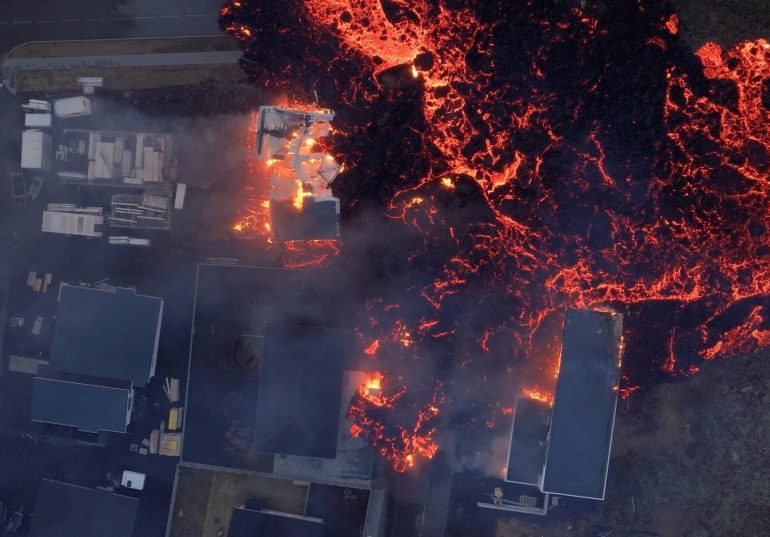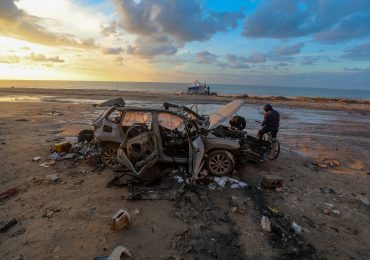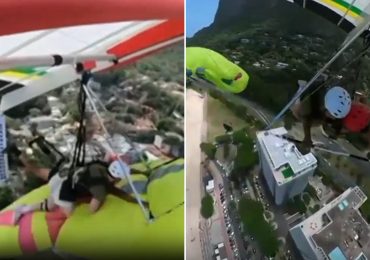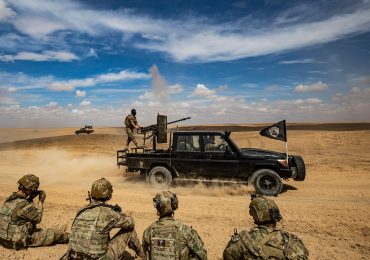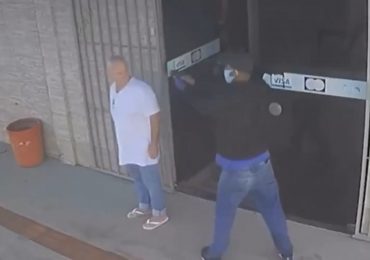TERRIFYING drone footage captured streams of fiery lava spilling into an Icelandic fishing town and setting homes ablaze following an eruption on Sunday.
The “worst case scenario” hit Grindavik last night as hastily-built defences were no match for the molten rock after it burst out of a new 3,000ft fissure inside the town.
ReutersThe devastating scenes of homes set ablaze by the fiery lava on Sunday[/caption]
AFPA huge cloud of reddish smoke darkens the fishing community of Grindavik as the lava flows moved towards the town overnight[/caption]
Drone footage later showed the lava setting houses alight and melting them
ReutersFurther footage showed molten rock spilling out into the streets and into ‘several homes’ after it a new fissure opened in Grindavik[/caption]
It was the second time in weeks that the community of 3,800 people were evacuated ahead of a new eruption on the Reykjanes peninsula that began at 8am on Sunday following a swarm of at least 200 earthquakes.
The seismic activity intensified last night as the stream of magma flowed perilously close to homes but rock barriers recently erected to protect the town just about held.
However, Civil defence chief Víoir Reynisson said the “worst case scenario” later occurred when a new fissure tore the earth open inside Grindavik and spewed scorching lava into “several homes”, Sky reports.
In the aerial footage, at least three homes were seen engulfed in the dark flames as they melted into the lava.
Prime Minister Katrín Jakobsdottir called it a “highly serious” situation.
“Because we were announcing yesterday that we were mostly worried about fissures and ruptures underneath the town, but now we have a volcanic eruption just really within the town. This is highly serious.”
Other horrifying footage captured from an Icelandic Coastguard helicopter shows huge pools of quickly spreading lava heading straight for the small fishing town.
“According to the first images from the Coast Guard’s surveillance flight, a crack has opened on both sides of the defenses that have begun to be built north of Grindavík,” the Icelandic Meteorological Office said in a statement overnight.
Iceland’s President Gudni Johannesson said on X/Twitter that “no lives are in danger, although infrastructure may be under threat”.
He said no flights had been disrupted by the eruption.
Lovísa Mjöll Guðmundsdóttir, of the Icelandic Meteorological Office, said: ‘It cannot be ruled out that more cracks will open.
“The GPS data showed us that there is increased magma inflow into the tunnel and with that there is a possibility of more fissures opening up.”
One option being considered is using pumps loaded with seawater to cool the lava to cool the lava down.
“This is serious, it’s basically as bad as it can possibly get. Although it might get even worse, who knows,” evacuated resident Jon Gauti Dagbjartsson said late on Sunday.
“I actually live in the house that I was born in and it’s a tough thought to think that this town might be over, and I would have to start all over somewhere else. But if that’s the case, then that’s exactly what we’ll do,” he said.
The Icelandic government will meet today to decide on support for the people of Grindavik.
Live video footage showed glimpses of orange lava still flowing to the surface but at smaller volumes, and further away from the town.
Police chief Víðir Reynisson warned that “we need to be prepared and focus our actions on the real danger, a large crack opening in Grindavík, major gas pollution from this and then the possible opening of new eruptions.”
Sunday’s eruption was the second eruption on the peninsula, 25 miles southwest of Iceland’s capital Reykjavík, in four weeks and the fifth since 2021.
In November, Grindavik residents had to move out to safety ahead of the largest volcanic eruption to date in their area when a series of earthquakes led to cracks and openings in the earth close to the town.
The local population described the horrors of being whisked from their homes as the ground shook, roads cracked and buildings threatened to collapse.
They were forced to stay away from the town for six weeks and were only allowed to return on December 22.
In the weeks since, defensive walls had been placed around the volcano in hopes of directing the magma away from the community – but they failed today.
Located between the Eurasian and the North American tectonic plates – among the largest on the planet – Iceland is a seismic and volcanic hot spot as the two plates move in opposite directions.
Reykjanes peninsula is home to 32 active volcanoes which were dormant for 800 years until 2021.
A British couple on holiday in Iceland when the volcano erupted said it was “alarming” to see all the ash and smoke as they travelled to the airport on Sunday.
Lorraine Crawford, 67, and her 70-year-old husband John, from Essex, took a trip to Reykjavik on Thursday along with Mr Crawford’s cousin, Michael Daltrey, and his wife, Faye.
“It’s alarming in a way – it’s quite exciting to see something like that but then you realise that this could do quite a lot of damage,” Mrs Crawford said.
“On the way [to the airport], we thought it was just a fire in the distance but [the taxi driver] said it was the actual volcano erupting.”
She added that they had heard a “really loud noise” and a “really loud rumble” from the airport, but they were not sure what had caused it.
AFPResidents were evacuated at 3am on Sunday as a swarm of earthquakes hit the peninsula ahead of the eruption[/caption]
GettyIt was the second time in weeks they were evacuated after a devestating eruption in December[/caption]
AFPIceland is a seismic and volcanic hotspot[/caption]
EPAOvernight, the fiery lava flows threatened to melt more houses[/caption]
Leave a comment
